There’s a long and interesting piece by John Ware in this month’s Standpoint, ‘The battle for British Muslims’ integration’. Its starting point is the recent row over hijabs in primary schools, but it goes on to offer a much broader critique of MEND.
I can agree with much of what he says; I wholeheartedly endorse his praise for Sara Khan, for example, and share his dislike of groups such as MEND. And the case of St Stephen’s School does indeed raise some real concerns about community peer pressure and the growing power of conservative Muslim voices.
However I’d like to pick out a few aspects which I found rather less constructive. It might be argued that these are mere details rather than substantive points; however sometimes it’s just this kind of detail which can prove distracting and prevent progress being made – and I don’t believe that was Ware’s intention.
By choosing to publish in Standpoint, Ware immediately positions his article in a very particular way. (This month’s editorial is called ‘Watchmen of the West’.) The cover depicts a shadowy niqabed figure and a little girl wearing hijab and abaya. This reminded me of the way in which the Daily Mail photoshopped a hijab into a niqab in this photograph in order to further sensationalise the much criticised Muslim foster story. In fact some mention of that story would have been a very helpful addition to Ware’s piece, a concrete acknowledgement of an issue which Muslims quite rightly pushed back on.
On p. 20 of the print edition of Standpoint Ware refers to ‘the latest clash between Islam and the values of British society’. This could be taken as implying that Islam and British society are inherently at odds with one another. I think it would have been truer to the spirit of the article – which very helpfully points out that only one child has taken up the option of wearing hijab since the ban at St Stephen’s School was overturned – to phrase this in a different way, perhaps targeting specific groups rather than Islam tout court. (In fact later Ware himself (p. 24)points out that it was misleading to conflate the hijab ban issue with British values.)
For similar reasons the reference to Churchill here also seemed unhelpful:
Or as Churchill might have put it, the influence of Islam “paralyses the social development of those who follow it” because “in Mohammedan law every woman must belong to some man as his absolute property.” (p. 20)
The term ‘Mohammedan’ is almost always now used as a slur, and I’m not sure how the quote improves the article. If this was a piece by Paul Weston it wouldn’t be worth commenting on, but if Ware wants Sara Khan’s views to gain traction – and I think he is fully sincere in expressing support for her and other liberal Muslims – then I don’t see how this helps.
Ware goes on to contrast some Muslim countries where dress reform is in the air with the UK:
Britain seems to be moving in the opposite direction with some pockets of our major cities and towns resembling — in appearance at least — a sort of caliphate. (p. 23)
Even with the caveat in parentheses this still seems an uncalled for parallel. And elsewhere Ware is much more precise in pinpointing exactly where he locates the problem.
[T]here is concern about how the hijab is being used by Islamist organisations to position conservative Islam in the mainstream. (p. 23)
Similarly many excellent points are made in the closing section of this long article – in particular a scathing attack on the critics of Sara Khan, the more kneejerk critics of Prevent and the loathsome 5 Pillars, together with praise for Muslim-led grassroots counter-extremism initiatives. But I think another possible problem creeps in when Ware turns to the challenges faced when trying to define extremism. Here he takes issue with Mend’s Siema Iqbal:
“Currently,” she writes “we have a commission to counter something we haven’t defined and don’t even know needs countering yet. Yes, it really is that bizarre.”
Actually it isn’t. Most people recognise intolerance and fundamentalism when they see it and it’s been on display in the reaction to Amanda Spielman and Neena Lall. (p. 27)
I am not denying there are extremist elements in the reactions to Spielman and Lall, but I think each one would need to be looked at before being classed in this way. It might be abusive, defensive, conservative, dissenting – but not necessarily extremist.


